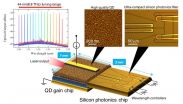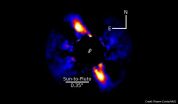Story tips from the Department of Energy's Oak Ridge National Laboratory, June 2015
2015-06-02
(Press-News.org) To arrange for an interview with a researcher, please contact the Communications staff member identified at the end of each tip. For more information on ORNL and its research and development activities, please refer to one of our media contacts. If you have a general media-related question or comment, you can send it to news@ornl.gov.
SOLAR - Suitability mapping ...
Using remote sensing data, researchers can efficiently determine optimum sites for solar power plants, according to a study led by Olufemi Omitaomu of Oak Ridge National Laboratory. With the target of solar energy providing up to 35 percent of the nation's total energy requirements by 2050, the need for strategic siting of solar plants is vital, Omitaomu said. He and colleagues in ORNL's Critical Infrastructure and Climate Change Group used a digital elevation model with 90-meter resolution to estimate global solar radiation. They added a computational model with overlays built on a geographic information system platform to divide the study area into a grid of cells to determine suitability for each cell. Their models also took into account population density, solar energy potential, federal lands and hazardous facilities. [Contact: Ron Walli, (865) 576-0226; wallira@ornl.gov]
LIGHTING - Safer landings ...
Airport runways could be highly visible under even the worst conditions with a lighting technology being developed by a team led by Oak Ridge National Laboratory. The prototype fixture features infrared and white light generators packaged in the industry standard PAR 38 configuration and uses ORNL's graphite foam. This provides cooling for the light emitting diodes and separately emits infrared light. While the LEDs that have replaced incandescent bulbs at many airports are efficient and bright, they aren't compatible with the enhanced vision systems (IR thermal cameras) onboard many planes. In addition to not being detectable by these systems, "Federal Aviation Administration-sponsored test pilots have reported 'blooming' and 'blinding' when the white light is produced by LEDs," said ORNL researcher James Klett. The light being developed in collaboration with Spectrum FML eliminates this problem. Evaluations of the new lights are slated for runways in Memphis. [Contact: Ron Walli, (865) 576-0226; wallira@ornl.gov]
ENERGY - Rooftop A/C retrofit ...
Through some nifty system coordination that limits the number of commercial rooftop air conditioning units that run simultaneously, a technique developed by Oak Ridge National Laboratory researchers can provide savings of thousands of dollars per year. Researchers expect the system, installed at a church in Knoxville, Tenn., to return the $1,200 investment in six months to a year. Compared to other complicated approaches that employ dozens of sensors and can cost thousands of dollars, the ORNL system receives data through public weather services and existing thermostat temperature sensors. The ORNL system effectively reduces costly peak demand - which happens when multiple units are running - by 50 percent. ORNL researcher James Nutaro noted that systems that cost thousands of dollars are unlikely to ever provide a return on investment. [Contact: Ron Walli, (865) 576-0226; wallira@ornl.gov]
ENERGY - Good vibrations dryer ...
Tomorrow's clothes dryers could use high-frequency mechanical vibrations instead of heat to extract moisture as a cold mist, dramatically reducing drying time and energy use. Oak Ridge National Laboratory and GE Appliances researchers are developing a prototype that uses ultrasonic transducers with an energy factor that greatly exceeds current heat-based technology. Drying times could be reduced to 15 to 20 minutes with potentially no shrinkage and no fading. "This project can potentially revolutionize the clothes dryer industry and provide 117 billion kilowatt-hours in energy savings," said Ayyoub Momen of the lab's Building Technologies Research and Integration Center. [Contact: Ron Walli, (865) 576-0226; wallira@ornl.gov]
INFORMATION:
ELSE PRESS RELEASES FROM THIS DATE:
2015-06-02
University of Adelaide researchers have discovered cerebral palsy has an even stronger genetic cause than previously thought, leading them to call for an end to unnecessary caesareans and arbitrary litigation against obstetric staff.
In an authoritative review published in the American Journal of Obstetrics & Gynecology, members of the Australian Cerebral Palsy Research Group, based at the University of Adelaide's Robinson Research Institute, argue that up to 45% of cerebral palsy cases can have genetic causes.
This builds on research published in February this year ...
2015-06-02
A study of marine mammals and other protected species finds that several once endangered species, including the iconic humpback whale, the northern elephant seal and green sea turtles, have recovered and are repopulating their former ranges.
The research, published in the June edition of Trends in Ecology and Evolution, suggests that some species, including humpback whales, have reached population levels that may warrant removal from endangered species lists.
But returning species, which defy global patterns of biodiversity loss, create an urgent new challenge for policymakers ...
2015-06-02
Researchers at Tohoku University and the National Institute of Information and Communications Technology (NICT) in Japan, have developed
a novel ultra-compact heterogeneous wavelength tunable laser diode. The heterogeneous laser diode was realized through a combination
of silicon photonics and quantum-dot (QD) technology, and demonstrates a wide-range tuning-operation.
The researchers presented their work at a Conference on Lasers and Electro-Optics (CLEO) in San Jose, California, on May 13. The related
paper was also be published in Applied Physics Express ...
2015-06-02
A research group at Tohoku University has succeeded in fabricating an atomically thin, high-temperature superconductor film with a superconducting transition temperature (Tc) of up to 60 K (-213°C). The team, led by Prof. Takashi Takahashi (WPI-AIMR) and Asst. Prof. Kosuke Nakayama (Dept. of Physics), also established the method to control/tune the Tc.
This finding not only provides an ideal platform for investigating the mechanism of superconductivity in the two-dimensional system, but also paves the way for the development of next-generation nano-scale superconducting ...
2015-06-02
An international team led by Thayne Currie of the Subaru Telescope and using the Gemini South telescope, has discovered a young planetary system that shares remarkable similarities to our own early solar system. Their images reveal a ring-like disk of debris surrounding a Sun-like star, in a birth environment similar to the Sun's. The disk appears to be sculpted by at least one unseen solar system-like planet, is roughly the same size as our solar system's Edgeworth-Kuiper Belt (commonly called the Kuiper Belt), and may contain dust and icy particles. This work provides ...
2015-06-02
Using a brand new survey method, researchers in Bergen have asked a broad spectrum of people in Norway about their thoughts on climate change. The answers are quite surprising.
Some 2,000 Norwegians have been asked about what they think when they hear or read the words "climate change". There were no pre-set answers or "choose the statement that best describes your view" options. Instead the respondents had to formulate their views on climate change in their own words. The answers have provided striking new insight into what the average person on the street in Norway ...
2015-06-02
Long-term changes in immune function caused by childhood trauma could explain increased vulnerability to a range of health problems in later life, according to new research by the Institute of Psychiatry, Psychology & Neuroscience (IoPPN) at King's College London and the NIHR Maudsley BRC.
The study, published today in Molecular Psychiatry, found heightened inflammation across three blood biomarkers in adults who had been victims of childhood trauma. High levels of inflammation can lead to serious and potentially life-threatening conditions such as type-2 diabetes, cardiovascular ...
2015-06-02
Treatment options for chronic hepatitis C, a serious and life-threatening infection, have improved substantially and several new regimens with shorter durations and improved efficacy and safety profiles are now available.
Groups have raised concerns about the evidence used to support the approval of some newer drugs, however, and the issue has been used to cast doubt on their efficacy and even to question treatment or deny reimbursement.
To address these concerns, the US Food and Drug Administration's Division of Antiviral Products in the Center for Drug Evaluation ...
2015-06-02
This news release is available in French. Montreal, June 2 -- A new study published by the team of Naguib Mechawar, Ph.D., a researcher with the McGill Group for Suicide Studies (MGSS) of the Douglas Institute (CIUSSS de l'Ouest-de-l'Ile de Montreal) and associate professor in the Department of Psychiatry at McGill University, sheds new light on the disruption of astrocytes in depression. Astrocytes, a class of non-neuronal cells, have previously been implicated in depression and suicide.
However, it was not known whether these cells were affected throughout the brain ...
2015-06-02
Los Angeles, CA (June 2, 2015) Neighborhoods with more interpersonal conflict, such as domestic violence and landlord/tenet disputes, see more serious crime according to a new study out today in Journal of Research in Crime and Delinquency (JRCD). Private conflict was a better predictor of neighborhood deterioration than public disorder, such as vandalism, suggesting the important role that individuals play in community safety.
"Private conflicts, for example, domestic violence or friendship disputes over money or girlfriends, can and do spill over into public spaces, ...
LAST 30 PRESS RELEASES:
[Press-News.org] Story tips from the Department of Energy's Oak Ridge National Laboratory, June 2015




